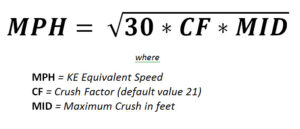 A question of interest in most collisions is “How fast was the car going?”
A question of interest in most collisions is “How fast was the car going?”
One method of beginning to determine the answer is to calculate speed from the crush to the vehicle. While there are several ways that this can be done, a method proposed by J. Stannard Baker and then refined by us at Expert Witness Services Inc. it to use what is commonly referred to as the “Speed from Skid” formula, but with a deceleration rate of 21 for a crushing vehicle as opposed to a more commonly seen 0.7-0.8 value for a skidding vehicle.
The benefits of this formula are several –
- Its easy to remember, since its a formula commonly used
- Its commonly used to calculate speed from braking, and so is familiar
- the calculation can be made quickly and with a basic calculatot, as opposed to a programmable calculator or computer.
- The speed arrived at has been generally reliable within a range of +/- 5 mph or less.
It is important to note that the speed calculated using this formula and a Crush Factor (CF) of 21 is not, except under certain circumstances, a delta-v or impact speed. Rather, it is what we refer to as a Kinetic Energy Equivalent Speed (KEES) and others refer to as a Barrier Equivalent Speed (BES), Barrier Equivalent Velocity (BEV), Equivalent Barrier Speed (EBS), and other terms and acronyms of a similar style. All of these labels are indicating the speed calculated is the Energy it would take to subject the vehicle to the amount of damage that is seen and documented expressed as a speed.
For more reading on this, we invite you to read some of the publications found on our Software site at – http://www.4n6xprt.com/papers/
While we hope you never need our expertise, if you need a Accident Reconstruction for yourself, a loved one, or friend, please consider the staff at Expert Witness Services Inc in your search for a service provider.

